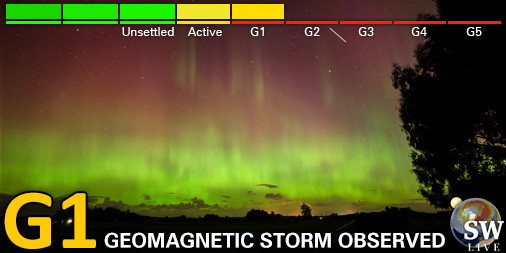Viewing archive of Tuesday, 29 June 1999
Geophysical report
Any mentioned solar flare in this report has a scaling factor applied by the Space Weather Prediction Center (SWPC). Because of the SWPC scaling factor, solar flares are reported as 42% smaller than for the science quality data. The scaling factor has been removed from our archived solar flare data to reflect the true physical units.
Solar and Geophysical Activity Summary 1999 Jun 29 0245 UTCPrepared by the NOAA © SWPC and processed by SpaceWeatherLive.com
Joint USAF/NOAA Solar and Geophysical Activity Summary
SGAS Number 180 Issued at 0245Z on 29 JUN 1999 This report is compiled from data received at SWO on 28 JUNA. Energetic Events
Begin Max End Rgn Loc Xray Op 245MHz 10cm Sweep 0114 0114 0115 180 0216 0216 0216 150 0431 0432 0432 720 0916 0916 0917 530 2055 2101 2117 C3.5 51 28 II
B. Proton Events
None.
C. Geomagnetic Activity Summary
THE GEOMAGNETIC FIELD RANGED FROM
QUIET TO MAJOR STORM LEVELS. THE MAJOR STORM CONDITIONS WERE SEEN
EARLY IN THE PERIOD COINCIDING WITH A SUDDEN IMPULSE AT 28/0304Z (20
NT).
D. Stratwarm
None
E. Daily Indices: (real-time preliminary/estimated values)
10 CM 197 SSN 268 AFR/AP 021/026 X-RAY BACKGROUND B9.6 DAILY PROTON FLUENCE (FLUX ACCUMULATION OVER 24 HRS) GT 1 MEV 6.7E+05 GT 10 MEV 1.3E+04 P/(CM2-STER-DAY) (GOES-8 SATELLITE SYNCHRONOUS ORBIT W75 DEGREES) DAILY ELECTRON FLUENCE GT 2 MEV 3.00E+05 E/(CM2-STER-DAY) (GOES-8 SATELLITE SYNCHRONOUS ORBIT W75 DEGREES) 3 HOUR K-INDICES: BOULDER 2 6 4 3 2 3 2 3 PLANETARY 2 6 5 3 3 3 3 3
F. Comments
None
All times in UTC
Current data suggests there is a slight possibility for aurora to appear at the following high latitude regions in the near future
Edmonton, AB, Gillam, MB, Iqaluit, NU, Saskatoon, SK, Whitehorse, YT, Yellowknife, NTJuneau, AK
Latest news
Latest forum messages
Unexplained proton activity 57Unspecified geomagnetic activity 2192AR4048 110SolarMax and FRAM2 2Changelog/Featurelog 169
More topicsSupport SpaceWeatherLive.com!
A lot of people come to SpaceWeatherLive to follow the Sun's activity or if there is aurora to be seen, but with more traffic comes higher server costs. Consider a donation if you enjoy SpaceWeatherLive so we can keep the website online!

Latest alerts
00:15 UTC - Geomagnetic activity
Minor G1 geomagnetic storm (Kp5) Threshold Reached: 23:59 UTC
Thursday, 3 April 2025
20:15 UTC - Geomagnetic activity
Minor G1 geomagnetic storm (Kp5) Threshold Reached: 20:02 UTC
13:03 UTC - Hemispheric Power Index
The OVATION model predicts the Hemispheric Power Index to reach 50GW at 13:56 UTC
Space weather facts
| Last X-flare | 2025/03/28 | X1.1 |
| Last M-flare | 2025/04/01 | M2.5 |
| Last geomagnetic storm | 2025/03/27 | Kp5 (G1) |
| Spotless days | |
|---|---|
| Last spotless day | 2022/06/08 |
| Monthly mean Sunspot Number | |
|---|---|
| March 2025 | 134.2 -20.4 |
| April 2025 | 143 +8.8 |
| Last 30 days | 130.4 -16.1 |




